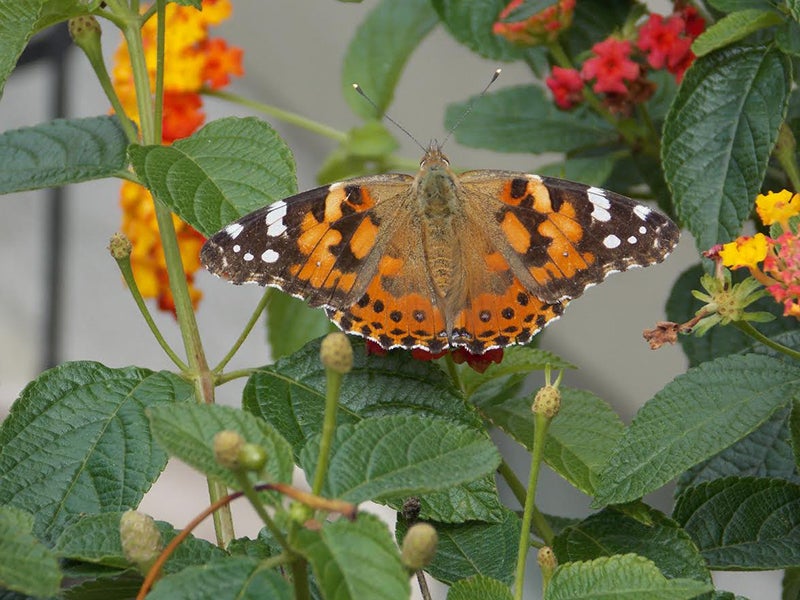Serendipity Gardens: Weather may have contributed to this year’s large painted lady population
Published 9:00 am Saturday, October 28, 2017

- This single painted lady butterfly was one of a swarm that visited the gardens this fall. -Carol Hegel Lang/Albert Lea Tribune
By Carol Hegel Lang
Carol Hegel Lang is a green thumb residing in Albert Lea. Her column appears weekly. Email her at carolhegellang@gmail.com.
The gardening season is done for this year and it sure will hold some wonderful memories for me.
The annuals I planted in the gardens alongside the driveway were filled with color and brought in so many birds and butterflies, as well as other insects. Between the migration of the monarchs and painted lady butterflies, it was an experience that will linger in my memory for years to come.

Carol Hegel Lang
The invasion, or irruption as some are calling it, of the painted lady — Vanessa cardui was something that I had never observed before and probably never will again. The outbreak was observed over many parts of the Midwest, including Colorado, North and South Dakota, Kansas, Iowa and Minnesota, as well as Canada.
A friend sent me an email with a map put out by the National Weather Service in Boulder, Colorado, showing a 70-mile-wide swarm of butterflies on its radar that meteorologists first thought was birds. After further investigation, it was proved to be painted lady butterflies. This was on Oct. 3, but many people had been noticing larger than normal numbers of them all summer in the various regions of the Midwest.
According to Jim Mason, director of Wichita’s Great Plains Nature Center, “exponentially more” than usual numbers were seen because of favorable weather in Oklahoma and Texas, which allowed multiple generations of them to survive. Sarah Garrett, lepidopterist with the Butterfly Pavilion in Denver, also commented on the large numbers being seen throughout the Front Range.
Painted ladies are often mistaken for monarchs, although they are smaller — with a wingspan less than 3 inches — and different in color. Painted ladies have eyespots on the underside of their wings and brown coloring on both sides. Their lifespan is two to four weeks.
According to Mason, they don’t migrate to warmer climates like monarchs who spend the winter in Mexico. They come north, breed, lay eggs and die, he said. Painted ladies are considered a cosmopolitan species that are found across the continental U.S. According to Colorado State University, however, they are a highly migratory species that is almost constantly in motion and will vacate the northern regions and head to extreme southwestern states and Baja, Mexico, for the winter. So, it is a bit confusing on whether or not they migrate. The best description that I found on them is that they are not permanent residents, but periodically migrate from the deserts of the southwestern U.S. and northern Mexico.
In an article written by Royce J. Bitzer, of the Deptartment of Entomology at Iowa State University, he states the first generation of painted ladies may have started in Southern California with the February to April bloom of the desert annuals providing plenty of food for the caterpillars. Heavy rainfall during the winter along the Pacific Coast from California to Washington along with the strong El Nino also contributed to favorable conditions for all the butterflies.
Whatever the reason, it was wonderful to see this invasion of beautiful butterflies.
In just a few weeks we will see hard frost, and then following it will be our first snowfall of the season. It will be time to snuggle into the warmth of our homes and remember the wonderful gardening season we had this past year.
It is always a love-hate relationship for me, this time of the year, as I hate to see the gardening season come to an end, but it is nice to have some down time after all the hard work we put into our gardens.
Just as we start to prepare for all of the holiday festivities, the garden catalogs arrive, and it is time to start making out my want lists for next year. You gotta love it. It seems like my lists grow longer every year, and now that I am planting more and more native plants, those catalogs get the majority of my attention. I already have a list of ephemerals that I want to order in January to make sure I don’t miss out on them.
“When we tug at a single thing in nature, we find it attached to the rest of the world.” — John Muir




